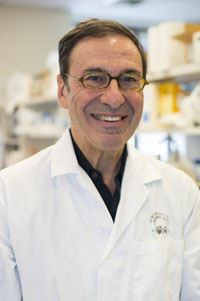An ongoing dialogue on HIV/AIDS, infectious diseases,
April 16th, 2017
Mark Wainberg and the Enduring Importance of 3TC
 Last week, the HIV/ID research world lost one of its leaders and pioneers when Dr. Mark Wainberg unexpectedly died. An astute, thoughtful virologist — and a warm, engaging person — he led the HIV research program at McGill University in Montreal for years, contributing to the field both through his research and patient advocacy. A strong voice in the effort to expand HIV therapy to Africa in the early 2000s, Mark was also a vocal critic of HIV denialism.
Last week, the HIV/ID research world lost one of its leaders and pioneers when Dr. Mark Wainberg unexpectedly died. An astute, thoughtful virologist — and a warm, engaging person — he led the HIV research program at McGill University in Montreal for years, contributing to the field both through his research and patient advocacy. A strong voice in the effort to expand HIV therapy to Africa in the early 2000s, Mark was also a vocal critic of HIV denialism.
If I had to single out one notable achievement, however, it would be this:
Then, in 1989, after studying the properties of a new antiviral drug called 3TC, or lamivudine, Dr. Wainberg found that it was effective against H.I.V. It soon became an important part of the so-called AIDS cocktail of drugs that is still used to treat infected patients.
This, of course, just hints at the critical role this drug has had in the success of HIV treatment. 3TC is the long-term superstar of the nucleoside reverse transcriptase inhibitor (NRTI) class, a characteristic it shares with the similar (and somewhat more potent) emtricitabine, or FTC.
Here are some of the highlights:
- Triple-therapy consisting of AZT, 3TC, and indinavir demonstrated durable virologic suppression for the first time. The protease inhibitor indinavir got lots of the credit for the success of this strategy since it represented a new drug class, but in these AZT-experienced patients — many of whom likely had extensive AZT resistance — the addition 3TC was arguably just as important.
- Resistance to 3TC improves susceptibility to AZT, d4T, and tenofovir. Having no resistance is clearly the best scenario, but if you have to have one resistance mutation, let it be M184V. This phenomenon could explain at least in part the results of the above study, or the ongoing benefit of recycled NRTIs in second-line trials (EARNEST, SECOND-LINE), where the activity of the NRTIs appears comparable to raltegravir — even though the latter is a new drug class.
- Resistance to 3TC isn’t really resistance after all. Despite massive phenotypic resistance to 3TC measured in vitro with viruses harboring the M184V mutation, several studies have demonstrated the ongoing antiviral effect of the drug anyway. In one study, stopping 3TC in patients with M184V led to prompt virologic rebound. In this other study, 3TC monotherapy delayed CD4 decline and virologic rebound compared with complete treatment interruption. Is it that M184V reduces viral fitness? That our phenotypic assays are wrong? Does it matter?
- Pretty much every “winner” in comparative clinical trials contains 3TC or FTC; conversely, strategies without these drugs often lose. There are so many examples it would take me a week to go through them all. Instead, I’ll just repeat the brilliant comment from Joel Gallant on this topic: “The best nuke [NRTI]-sparing strategy contains a nuke.”
- 3TC might be the key component to successful 2-drug therapy. The GARDEL study of LPV/r plus 3TC was the first hint that this strategy could break the rule that combination therapy must contain three active drugs. This success has now been followed by studies in virologically suppressed patients “deintensified” to a boosted PI (LPV/r, ATV/r, or DRV/r) plus 3TC, each demonstrating ongoing virologic success when the third (non-3TC) NRTI was dropped. Since boosted PIs are no longer first-line therapy, an important question is whether the same success will be seen with DTG plus 3TC — studies are ongoing.
Of course none of the above success with 3TC or FTC containing regimens would be possible were the drugs not extraordinarily well-tolerated. This safety profile makes 3TC among the few drugs approved in the 1990s still in wide use today.
We will very much miss Dr. Mark Wainberg. His legacy lives on with the people he trained, his extraordinarily productive research career, the expansion of HIV treatment globally — and with the miraculous drug 3TC.
Save



well done paul thanks
His legacy indeed lives on…..